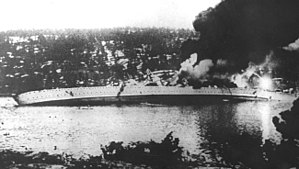Battle of Drøbak Sound
| Battle of Drøbak Sound | |||||||
|---|---|---|---|---|---|---|---|
| Part of the Norwegian Campaign of World War II | |||||||
 Blücher sinking in the Oslofjord. |
|||||||
|
|||||||
| Belligerents | |||||||
|
|
|
||||||
| Commanders and leaders | |||||||
| Birger Eriksen (POW) |
Oskar Kummetz (POW) August Thiele |
||||||
| Strength | |||||||
|
Oscarsborg Fortress: One company of the Norwegian Royal Guards Total crew: 45 officers 293 NCOs and men, 69 officers and men of the Norwegian Royal Guards |
2 heavy cruisers 1 light cruiser 1 torpedo boat 2 minesweepers |
||||||
| Casualties and losses | |||||||
| No casualties, although most buildings above ground at the Main Battery were burnt to the ground. | 1 heavy cruiser sunk 1 heavy cruiser damaged 650–800 dead ca. 50 wounded c. 1,000 temporarily taken prisoner |
||||||
|
Civilian casualties: Three houses destroyed and two women killed by stray German shells in nearby Drøbak. Cargo cutter Sørland sunk by German minesweepers with the loss of two crewmen. Cargo ship Halden I damaged |
|||||||
Decisive Norwegian victory
Oscarsborg Fortress:
Main Battery:
3 × 28 cm coastal guns
4 × anti-aircraft machine guns
Kopås Battery:
3 × 15 cm coastal guns
Husvik Battery:
2 × 57 mm mine barrier protection guns
Torpedo Battery:
3 × double land based underwater launch tunnels for 45 cm torpedoes
3 × single land based underwater launch tunnels for 45 cm torpedoes
Seiersten Battery:
2 × Bofors 40 mm L/60
anti-aircraft guns
3 × Colt M/29 7,92 mm anti-aircraft machine guns
Håøya Battery:
4 × Colt M/29 7,92 mm anti-aircraft machine guns
Nesset Battery:
4 × 57 mm Cockerill L/60 guns
The Battle of Drøbak Sound took place in the northernmost part of the Oslofjord on 9 April 1940, on the first day of the German invasion of Norway. It was the start of the war in Western Europe—and an end to the "Phoney War".
Oscarsborg Fortress near Drøbak engaged a German fleet sailing up the Oslofjord with the objective of seizing the Norwegian capital and capturing Haakon VII, the Norwegian king, and his government. At the time of the battle, the ageing fortress' Main Battery of guns was over 40 years old and the installation had been relegated to training coastal artillery servicemen, leading the Germans to disregard the fortress' defensive value. Furthermore, the most powerful weapon of the fortress was a torpedo battery, which no one but the Norwegian military knew about.
In the end, the fortress' armament worked flawlessly. By sinking the lead ship of the German armada headed for Oslo, Oscarsborg Fortress saved the Norwegian king and government from being taken captive in the first hours of the invasion.
...
Wikipedia
